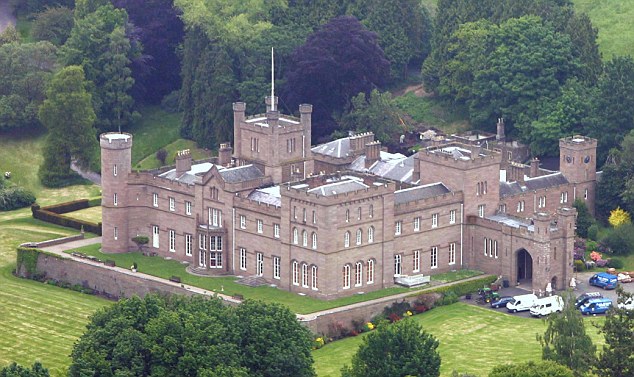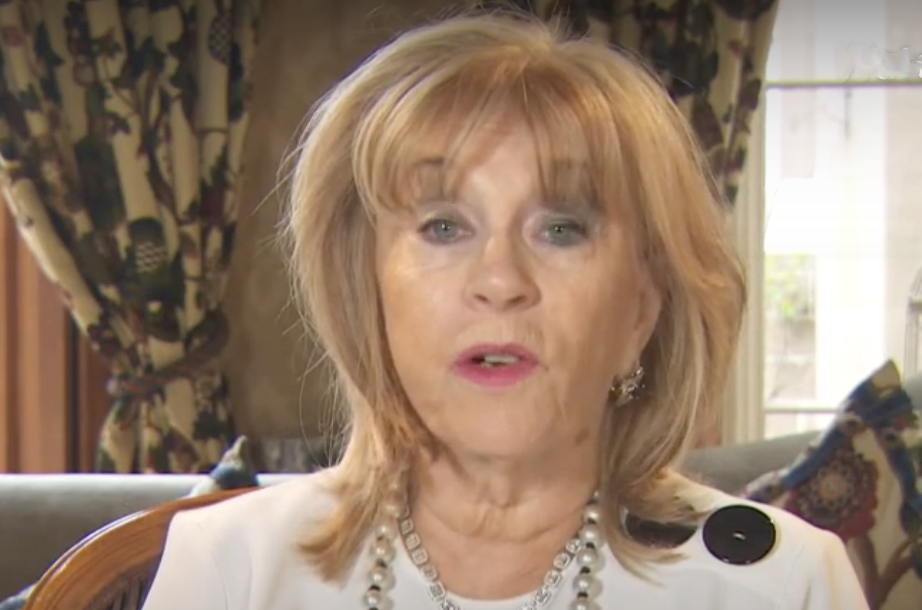Ann Gloag and Human Traffic 61
Scotland has no shortage of dreadful right wing judges, but as the very epitome of reactionary conservatism, one gobsmacking judgment from Perth Sheriff Michael Fletcher stands out.
In a major rowing back of Scotland’s right to roam legislation contained in the Land Reform (Scotland) Act 2003, Sheriff Fletcher ruled that plebs must not be allowed within many acres of rich people’s mansions, because the thieving commoners may rob the rich people.
That really is precisely what he ruled.
53] While I accept that it is quite possible that the average proprietor of Kinfauns Castle might not have the resources or the tastes or the interests of the pursuer in this case it is I think legitimate to infer from the nature of the premises and in particular its value and cost to run that any person using the premises as a private house would require to have very substantial resources. It is also legitimate to infer from the evidence that such a person would be likely to be the possessor of valuable objects of some kind be it furniture or pictures or jewellery or at least to infer that outsiders including those of a criminal disposition might think that the owner of the Castle would have valuable possessions. If that is so then any such proprietor would have concerns as to whether their premises were secure and thus the evidence relating to security assumes some significance. It may be that the reasonable proprietor of the Castle might not have the same finely tuned concerns about security that were offered in evidence on behalf of the pursuer and might not require elaborate precautions such as tamper detectors and other electronic devices, but I think it can be inferred from the evidence that any owner would have greater or lesser security concerns more highly developed than most other householders in the country.
….
[55] No one in my view would have their enjoyment of their private house ensured if they were concerned about the security of the premises either from the point of view of theft or some sort of attack. If I am correct that most inhabitants of such a house would be persons with substantial assets then I consider that all such persons would have some concerns about security and it would be expected that their enjoyment of the house would be able to be ensured only if they were happy that the security of the premises was taken care of.
“Taken care of” specifically meaning by excluding the public right to roam for many acres around their house. Because they have a big house and so are “persons with substantial assets”, and thus the law should treat them differently to the plebs.
He further ruled that, where there had been a fence erected before the passing of the 2003 right to roam legislation, that fence should be respected as the boundary where the right to roam legislation did not permit access, as that fence would indicate where the historic castle owners reasonably believed it was necessary to exclude the public in order to protect their own privacy.
Yes, he specifically stated that the Land Reform legislation could not alter the boundaries to public access previously set by estate owners’ fences, and it is historic estate owners’ opinion on where they should exclude the public, that is the only opinion that counts.
[56] Another consideration arising from the characteristics of the house seems to me to arise from the evidence again unchallenged of Mr McCleary that the fence erected by the pursuer was erected following at least for some of the way but probably for most of the way a fence which was already in existence albeit in poor condition. Mr McCleary described it as what I think could be described as a stob and wire fence with perhaps two wires and about waist height. Such a fence could not be described in any respect as a security fence but it is significant in my view that the fence was not one which surrounded the whole of the property owned by the owners of the Castle but travelled at least part of the way through the property so that property owned by the Castle was both inside and outside the fence. Counsel for the respondents argued that there was no significance in the fact that there was a fence there partly because it was erected at a time when it was perfectly possible to own land privately. I consider that it is legitimate to take into account that the fence was built on the line of an original fence, or more precisely a previous fence. It is clear that the fence would not have prevented anyone who desired to do so from entering the premises but standing its condition it was probably erected at a time when the existence of such a fence would indicate to the vast majority of people that they were coming to land owned privately. When one is trying to assess what is sufficient land adjacent to the house to afford reasonable measures of privacy in the house and to ensure the enjoyment of the persons living there is not unreasonably disturbed it seems to me to be not unreasonable to take into account the boundaries established by persons not influenced in any way by the new rights created by Parliament in relation to access across private property at least as an adminicle of evidence. It is I think legitimate consider that such boundaries were placed there on the basis that persons considered that ground within the boundary would be required to secure their privacy and enjoyment of the property especially when the fence was not erected automatically on the boundary of the land owned by the house. For these reasons I have taken the line of the fence as being a pointer to what might be considered by persons occupying the house as reasonably required for the enjoyment of the house.
Sheriff Fletcher, in a ruling since quoted by estate owners all over Scotland, ruled that Ann Gloag was entitled to fence off 12 acres around her castle as “private garden”, and keep out the little people.
He did not stop there. In a pointer to roll back the Act’s victory over repressive rulings of criminal trespass, Sheriff Fletcher stated that Mr Morris of the Ramblers’ Association should have been charged by the police with breach of the peace when he entered the gates of the estate to check on compliance with the 2003 Act, and refused to leave when asked to by a land manager in a Land Rover.
Sheriff Fletcher plainly felt that for ramblers to disobey orders from people in Land Rovers is the first step to Marxist insurrection and the guillotine.
The case was brought in 2007 by Ann Gloag, owner of Kinfauns Castle against Perth and Kinross Council and the Ramblers’ Association, to stop walkers from transiting or just enjoying her estate of Kinfauns Castle, outside Perth.

Ann Gloag’s Perth home, Kinfauns Castle.
(Please see Gordon Currie story 01738 446766).
NO BYLINE TO BE USED WITH IMAGE.
COPYRIGHT: Perthshire Picture Agency.
Tel. 01738 623350 / 07775 852112.
Sheriff Fletcher also stuck the Council and Ramblers Association with £160,000 of Gloag’s legal costs. Probably as a result the case was never appealed – that was also a realistic assessment of the predelictions of Scotland’s estate weekending senior judiciary.
The Gloag judgment remains a huge bleeding hole in the intent of the 2003 Land Reform Act on public access to land.
Politicians huffed following this judgement about the need to amend the Act to make plain the precedence of public access –
As the Guardian reported at the time:
Yesterday, senior figures in the ruling Scottish National party, which has championed land access legislation, said the act must be reviewed and if necessary tightened, while the ramblers urged the Crown Office, which oversees Scottish courts, to issue guidance to clarify the legal position.
Roseanna Cunningham, a nationalist and the local MSP, put down emergency questions on the case at Holyrood yesterday. “If the Queen doesn’t require fences at Balmoral, I’m not entirely clear why they’re needed at Kinfauns. I hope we’re not going to sit by and watch this being eroded,” she said.
But nothing happened, in Scotland’s timid parliament of the bought. Instead we got the exact opposite, with the Scottish Government incoporating the Gloag judgment in its countryside access code, as a restriction.
That is just another heart-rending example of the gap between what the SNP claims to stand for, and how it behaves in government.
Anyway, “Dame” Ann Gloag, who detests human traffic across her property, has now been charged with human trafficking related to the operation of her African oriented charities, and persons brought to Scotland.
One effect, of course, of the extensive privacy and large right of access exclusion zone granted to Dame Ann Gloag, is that all domestic servants and other persons working at the castle, in whatever capacity and voluntarily or not, would be removed from the possibility of public view.
It would therefore be most interesting in terms of Sheriff Fletcher’s judgment if any of the alleged trafficking activity relates to the Kinfauns estate. Watch this space.
On the other hand I view the Crown Office, to which Police Scotland have handed the dossier, as entirely corrupt and shall be most surprised if there is a prosecution.
I ran across Ms Gloag’s interests when I lived in Ramsgate in Kent from 2007 to 2014. My home was under two miles from Manston Airport, at that time a struggling commercial airport on which many local jobs depended.
In November 2013, with the close involvement of Thanet District Council, Ann Gloag purchased Manston Airport for just £1, on the assurance that she would keep it running for at least two years.
Within a very few months Gloag had closed down the airport, with substantial harm to the local economy, and submitted plans for an extremely profitable scheme to build 1,000 homes – the first phase on just part of the massive site.
Gloag turned down a £7 million offer to buy the airport from a company willing to keep it open.
You can still find online this introduction to an ITN investigation into what happened:
Meridian investigation has discovered that after private meetings with senior officers from Thanet District Council, Manston Airport owner Ann Gloag believed there was the potential for large-scale house-building on the site.
Was that why she rejected a £7m buyout offer that would have kept the airport operational and saved 140 jobs? John Ryall has this exclusive report.
Sadly the investigation itself has disappeared. I wonder whether Dame Ann Gloag’s legal friends have been at it again?

You will gather I am not a fan of Dame Ann Gloag. But then why would she care what we think? We are not permitted within acres of her home.
Yet everything I have written above obviously is a complete fiction, because according to the BBC’s James Cook, the human trafficking charges against Ann Gloag are an incredible shock because she is the most saint-like and unimpeachable human being the world has ever known.
She is vouched for by Gordon and Sarah Brown, for goodness sake. (Gordon Brown not being at all a war criminal complicit in the awful deaths of millions of people in Iraq and across the Middle East). She is vouched for by lots of heads of charities who get six figure salaries for patronising Africans.
In fact James Cook could find nothing at all worrying or controversial to write about Dame Ann Gloag. Her cupboard is apparently full of Christ like charity and zero skeletons.
Dame Ann has been charged with human trafficking. Now I am not an expert on media contempt of court, except that I am the only living person in Scotland ever to have gone to jail for it. But now that Dame Ann has actually been charged, is it really OK for James Cook to publish that:
“A source close to Dame Ann told the BBC that the family were “victims of collusion” and had endured “a Kafkaesque nightmare for the last two years.”
The source added: “Everybody is bewildered by these accusations and the level of this investigation.
“It is deeply ironic that Dame Ann actually funds an Eastern European charity called the Open Door Foundation whose job it is to stop the trafficking of poor women into sex crimes.
“She is very attuned to the real dangers that are going on in this world.
“This is bizarre. We are dealing with technicalities.
“There are countless people who are stepping forward to support Dame Ann from around the world.”
Is that not material likely to influence a jury? And if James Cook is allowed to publish this, am I allowed to say that my position on Dame Ann Gloag’s saintliness is one of extreme scepticism?
Do read James Cook’s piece. It really is quite astonishing hagiography of somebody with so much controversy in their past, now charged with a serious crime by Police Scotland.
It is astonishing hagiography even coming from Scotland’s smarmiest sycophant and stager of false incidents.

Incidentally, I do not mean to make too much of this next as it is probably simply a muddle arising from Cook’s inability to make coherent sentences, but I did a double take on this sentence in his piece.

I give you Dame Ann Gloag. Fit to stand alongside Baroness Michelle Mone as exemplars of titled Scottish businesswomen.

————————————————-
Forgive me for pointing out that my ability to provide this coverage is entirely dependent on your kind voluntary subscriptions which keep this blog going. This post is free for anybody to reproduce or republish, including in translation. You are still very welcome to read without subscribing.
Unlike our adversaries including the Integrity Initiative, the 77th Brigade, Bellingcat, the Atlantic Council and hundreds of other warmongering propaganda operations, this blog has no source of state, corporate or institutional finance whatsoever. It runs entirely on voluntary subscriptions from its readers – many of whom do not necessarily agree with the every article, but welcome the alternative voice, insider information and debate.
Subscriptions to keep this blog going are gratefully received.
Choose subscription amount from dropdown box:
Paypal address for one-off donations: [email protected]
Alternatively by bank transfer or standing order:
Account name
MURRAY CJ
Account number 3 2 1 5 0 9 6 2
Sort code 6 0 – 4 0 – 0 5
IBAN GB98NWBK60400532150962
BIC NWBKGB2L
Bank address Natwest, PO Box 414, 38 Strand, London, WC2H 5JB
Bitcoin: bc1q3sdm60rshynxtvfnkhhqjn83vk3e3nyw78cjx9
Ethereum/ERC-20: 0x764a6054783e86C321Cb8208442477d24834861a
Subscriptions are still preferred to donations as I can’t run the blog without some certainty of future income, but I understand why some people prefer not to commit to that.